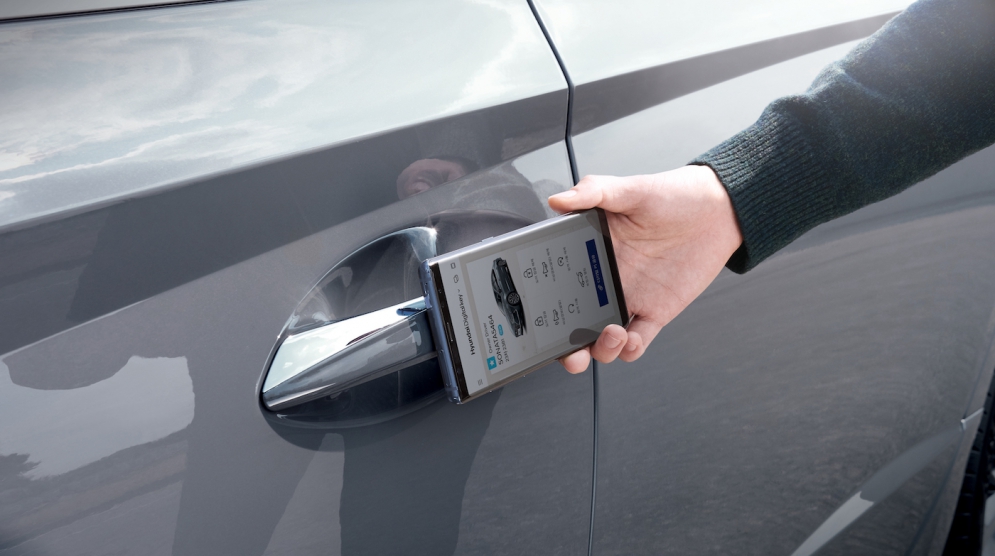LOOKS
The sleek Hyundai Sonata features a classy exterior design that distinguishes itself from the competition, which is important since many vehicles in this class tend to look similar.
My test vehicle featured a Hampton Gray exterior paint color, 19-inch alloy wheels, a panoramic sunroof, LED headlights, and heated side mirrors with turn signal indicators.
The Sonata also features automatic high-beams; remote keyless entry; heated front seats; and dual-zone automatic climate control. Seating materials offered include cloth, simulated leather, and leather.
Also available are ambient interior lighting, heated steering wheel and ventilated front seats, and the N Line version of the Sonata comes with its own bolstered seats, plus N Line styling.
The Sonata features quality materials and offers comfy and roomy seating for all passengers, and my test vehicle featured black seats with red stitching. But it’s not going to be at a luxurious level. The trunk offers 16 cubic feet of storage, which is competitive for the segment, and rear seats can fold down to increase cargo capacity.
The Sonata features well-designed controls for climate and tech commands. Another unique feature is that a set of buttons are used for shifting instead of a traditional shifter.
HOW’S THE RIDE?
Multiple engines are offered in the Hyundai Sonata, and my test vehicle featured a 1.6-liter turbocharged, four cylinder engine, with output of 180 horsepower and 195 pound-feet of torque. This was paired with an 8-speed automatic transmission, though paddle shifters were also included.
The 2023 model I drove was FWD, and no AWD options were available. However, the good news is that some of the 2024 Sonata models will come with the option of AWD, catching them up to competitors in an area where they were lacking up until now.
The most powerful engine offered on the Sonata comes on its N-Line model, with a turbo 2.5-liter four-cylinder engine offering 290 horsepower and 311 pound-feet.
In my testing, zero-to-60 times came in a hair over 7 seconds with the Sonata model I tested, though it’s worth noting that N-Line models will do the deed in roughly 5 seconds.
More adventurous drivers who want as much of a rocket as possible will be tempted to go for the N Line option, but those who want to save some dough and still get a respectable, smooth daily driver will be fine with the lower levels of the Sonata lineup.
The overall experience behind the wheel of the Sonata isn’t the best you’ll find in this segment, but it’s not one to sneeze at either. Multiple drive modes are offered, including Smart (eco-friendly option), Normal (for everyday driving), Sport (the most fun option) and Custom.
The Sonata’s ability to handle sharp corners and other maneuvers that require strong driver input was respectable, and I experienced no issues with situations like highway merging or passing where speed was necessary to make something happen.
TECHNOLOGY, SAFETY
The Hyundai Sonata I tested featured a large, wide, attractive and clean-looking touchscreen measuring at 10.25 inches. Voice commands worked effectively, and controls on both the steering wheel and the touchscreen were easy to master. The wireless smartphone charger up front comes in handy, and you also have access to USB ports and a 12-volt charger.
There was also a fully digital display in front of the driver, and a 12-speaker Bose stereo system, plus Apple CarPlay and Android Auto smartphone integration, and access to Hyundai’s Bluelink connected services (remote start, lock and unlock doors, etc., via app).
The Sonata also allows for Hyundai Digital Key, which lets you unlock your car by touching the door with your smartphone or smart watch.
Moving on to safety, the Sonata gets stellar government safety ratings, which is important for families seeking the safest sedan possible.
It also features a bevy of safety systems that enhance your safety on the roadways, all of which worked well in my experience and were not overly sensitive.
These systems include:
— Forward collision warning with automatic braking, to help prevent crashes
— Adaptive cruise control, to maintain distance between yourself and the vehicle in front of you
— Lane keeping assistance, which literally pushes you back into your lane when necessary
— Blind-spot intervention, which won’t let you switch lanes if a vehicle is already occupying the next lane
— Rear cross-traffic alert, which lets you know about approaching vehicles in your path as you back up
— Safe exit warning, which alerts you so you don’t open your door into approaching traffic
Another system of note is the driver attention warning, which senses if the driver is becoming fatigued and inattentive, and could be helpful on longer road trips.
Other highlights include a head-up display, a blind-spot camera that pops up in your digital gauge cluster, and the Smart Parking Assist feature (which allows the vehicle to pull into or out from a parking space by itself).
MPG
The official fuel mileage numbers on the Sonata I tested were 27 city/37 highway/31 combined. In my real world testing, I averaged just over 28 miles per gallon in the Sonata.
These numbers were mostly competitive in the midsize sedan category, though some rivals do outperform the Sonata in this category. The difference, though, isn’t extreme, so this shouldn’t be a deciding factor for most buyers.
Also of note: If you opt for the hybrid version of the Sonata, you can get upwards of 50 miles per gallon.
PRICE
The Hyundai Sonata that I tested was priced at $33,600; base price starts around $26K. This is competitive pricing for the midsize sedan segment, and positions the Sonata well for buyers who are looking for value while not sacrificing features.
The Sonata also has in its back pocket an excellent set of warranties that are among the best you’ll find in any vehicle. They include:
— 5-year, 60,000 mile new vehicle warranty
— 10-year, 100,000 mile powertrain warranty
— 7-year, unlimited mile anti-perforation warranty
— 3-year, 36,000 mile complimentary maintenance
— 5-year, unlimited mile roadside assistance
BOTTOM LINE
The Hyundai Sonata is a capable midsize sedan, with a sharp design that stands out in the segment, as well as strong tech and safety features, and a strong warranty.
Just don’t come in expecting big power unless you go for the very capable N-Line version. Other models should be approached with more realistic expectations.
===
AutoTechReviews.com can be found on Twitter @AutoTechReview, or stay updated at the AutoTechReviews Facebook page. Follow AutoTechReviews on Instagram at @Autotechreviews. Matt Myftiu can be found on Twitter @MattMyftiu




